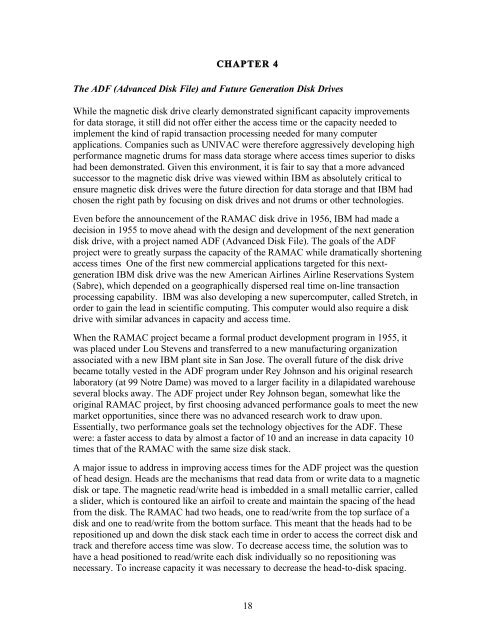final book al hoagland - Archive Server - Computer History Museum
final book al hoagland - Archive Server - Computer History Museum
final book al hoagland - Archive Server - Computer History Museum
You also want an ePaper? Increase the reach of your titles
YUMPU automatically turns print PDFs into web optimized ePapers that Google loves.
CHAPTER 4<br />
The ADF (Advanced Disk File) and Future Generation Disk Drives<br />
While the magnetic disk drive clearly demonstrated significant capacity improvements<br />
for data storage, it still did not offer either the access time or the capacity needed to<br />
implement the kind of rapid transaction processing needed for many computer<br />
applications. Companies such as UNIVAC were therefore aggressively developing high<br />
performance magnetic drums for mass data storage where access times superior to disks<br />
had been demonstrated. Given this environment, it is fair to say that a more advanced<br />
successor to the magnetic disk drive was viewed within IBM as absolutely critic<strong>al</strong> to<br />
ensure magnetic disk drives were the future direction for data storage and that IBM had<br />
chosen the right path by focusing on disk drives and not drums or other technologies.<br />
Even before the announcement of the RAMAC disk drive in 1956, IBM had made a<br />
decision in 1955 to move ahead with the design and development of the next generation<br />
disk drive, with a project named ADF (Advanced Disk File). The go<strong>al</strong>s of the ADF<br />
project were to greatly surpass the capacity of the RAMAC while dramatic<strong>al</strong>ly shortening<br />
access times One of the first new commerci<strong>al</strong> applications targeted for this next-<br />
generation IBM disk drive was the new American Airlines Airline Reservations System<br />
(Sabre), which depended on a geographic<strong>al</strong>ly dispersed re<strong>al</strong> time on-line transaction<br />
processing capability. IBM was <strong>al</strong>so developing a new supercomputer, c<strong>al</strong>led Stretch, in<br />
order to gain the lead in scientific computing. This computer would <strong>al</strong>so require a disk<br />
drive with similar advances in capacity and access time.<br />
When the RAMAC project became a form<strong>al</strong> product development program in 1955, it<br />
was placed under Lou Stevens and transferred to a new manufacturing organization<br />
associated with a new IBM plant site in San Jose. The over<strong>al</strong>l future of the disk drive<br />
became tot<strong>al</strong>ly vested in the ADF program under Rey Johnson and his origin<strong>al</strong> research<br />
laboratory (at 99 Notre Dame) was moved to a larger facility in a dilapidated warehouse<br />
sever<strong>al</strong> blocks away. The ADF project under Rey Johnson began, somewhat like the<br />
origin<strong>al</strong> RAMAC project, by first choosing advanced performance go<strong>al</strong>s to meet the new<br />
market opportunities, since there was no advanced research work to draw upon.<br />
Essenti<strong>al</strong>ly, two performance go<strong>al</strong>s set the technology objectives for the ADF. These<br />
were: a faster access to data by <strong>al</strong>most a factor of 10 and an increase in data capacity 10<br />
times that of the RAMAC with the same size disk stack.<br />
A major issue to address in improving access times for the ADF project was the question<br />
of head design. Heads are the mechanisms that read data from or write data to a magnetic<br />
disk or tape. The magnetic read/write head is imbedded in a sm<strong>al</strong>l met<strong>al</strong>lic carrier, c<strong>al</strong>led<br />
a slider, which is contoured like an airfoil to create and maintain the spacing of the head<br />
from the disk. The RAMAC had two heads, one to read/write from the top surface of a<br />
disk and one to read/write from the bottom surface. This meant that the heads had to be<br />
repositioned up and down the disk stack each time in order to access the correct disk and<br />
track and therefore access time was slow. To decrease access time, the solution was to<br />
have a head positioned to read/write each disk individu<strong>al</strong>ly so no repositioning was<br />
necessary. To increase capacity it was necessary to decrease the head-to-disk spacing.<br />
18
















